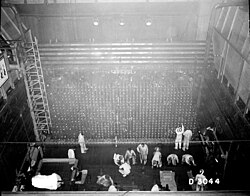Hanford B Reactor
|
Hanford B Reactor
|
|

The face of B Reactor during construction.
|
|
| Location | Near junction of WA 24 & WA 240 on the Hanford Site |
|---|---|
| Nearest city | Richland, Washington |
| Built | June 7, 1943 to September 1944 |
| Architect | E.I. DuPont de Nemours & Co. |
| NRHP Reference # | 92000245 |
| Significant dates | |
| Added to NRHP | April 3, 1992 |
| Designated NHL | August 19, 2008 |
The B Reactor at the Hanford Site, near Richland, Washington, was the first large-scale nuclear reactor ever built. The project was commissioned to produce plutonium-239 by neutron activation as part of the Manhattan Project, the United States nuclear weapons development program during World War II. The B reactor was fueled with metallic natural uranium, graphite moderated, and water-cooled. It has been designated a U.S. National Historic Landmark since August 19, 2008 and in July 2011 the National Park Service recommended that the B Reactor be included in the Manhattan Project National Historical Park commemorating the Manhattan Project. Visitors can take a tour of the reactor by advance reservation.
The reactor was designed and built by E. I. du Pont de Nemours and Company based on experimental designs tested by Enrico Fermi at the University of Chicago, and tests from the X-10 Graphite Reactor at Oak Ridge National Laboratory. It was designed to operate at 250 megawatts (thermal).
The reactor occupies a footprint of 46 by 38 ft (14 by 12 m) (about 1,750 sq ft (163 m2) and is 41 ft (12 m) (approximately five stories) tall, occupying a volume of 71,500 cu ft (2,020 m3). The reactor core itself consisted of a 36-foot-tall (11 m) graphite box measuring 28 by 36 ft (8.5 by 11.0 m) occupying a volume of 36,288 cu ft (1,027.6 m3) and weighing 1,200 short tons (1,100 t). It was penetrated horizontally through its entire length by 2,004 aluminum tubes and vertically by channels for the vertical safety rods.
...
Wikipedia
